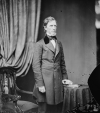She was designed for cruising the Great Lakes and was therefore decommissioned and laid-up each winter, usually sometime in December. Her crew was discharged at this time as well. She was re-commissioned each spring for her patrol season, with a new crew hired on for the year. Her home port was originally Detroit and her cruising grounds were Lake Huron and Lake Michigan. After 1893 her cruising ground was Lake Erie to the Niagara River. In 1903 she steamed to Baltimore for repairs and entered back into commissioned service on 14 November 1905. From 1905 until she left the service permanently in 1907, she was based out of Key West, Florida. Her cruising grounds now consisted of the waters off southern Florida and into the Gulf of Mexico.
In 1905 her officers conferred with state officials regarding the protection of the sponge industry. She and her crew were briefly detained at Mullet Key Quarantine Station when a case of small pox broke out on board in March, 1906. She saved a number of schooners that were adrift after a storm in June, 1906 and the following month examined vessels engaged in gathering sponges. That fall and winter she cruised the Gulf of Mexico in search of vessels in distress.
She steamed for Curtis Bay, Maryland in May, 1907, arriving there on 6 June 1907. Here her officers and crew transferred to the cutter Forward on 7 August 1907 and on the 14th Fessenden was decommissioned. She was decommissioned in 1907 and sold in March 1908 to the Craig Shipbuilding Company of Toledo, OH, for $9,100.
| Back to the Main Photo Index | Back to the Revenue Cutter Photo Index |
| Comments, Suggestions, E-mail Webmaster |
|
This page created by Joseph M. Radigan and maintained by David Wright |


